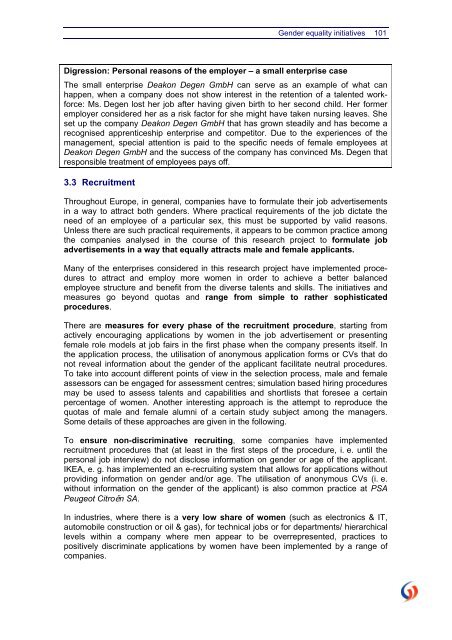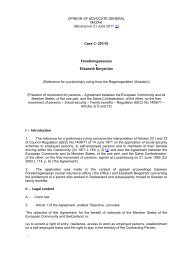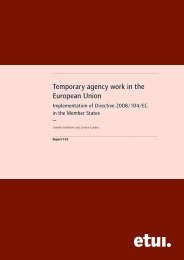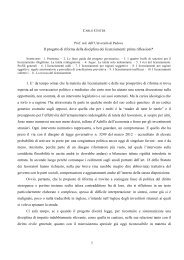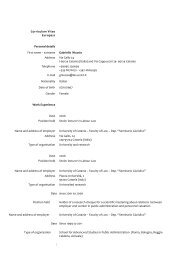Study on non-legislative initiatives for companies to promote gender ...
Study on non-legislative initiatives for companies to promote gender ...
Study on non-legislative initiatives for companies to promote gender ...
Create successful ePaper yourself
Turn your PDF publications into a flip-book with our unique Google optimized e-Paper software.
Gender equality <strong>initiatives</strong> 101<br />
Digressi<strong>on</strong>: Pers<strong>on</strong>al reas<strong>on</strong>s of the employer – a small enterprise case<br />
The small enterprise Deak<strong>on</strong> Degen GmbH can serve as an example of what can<br />
happen, when a company does not show interest in the retenti<strong>on</strong> of a talented work<strong>for</strong>ce:<br />
Ms. Degen lost her job after having given birth <strong>to</strong> her sec<strong>on</strong>d child. Her <strong>for</strong>mer<br />
employer c<strong>on</strong>sidered her as a risk fac<strong>to</strong>r <strong>for</strong> she might have taken nursing leaves. She<br />
set up the company Deak<strong>on</strong> Degen GmbH that has grown steadily and has become a<br />
recognised apprenticeship enterprise and competi<strong>to</strong>r. Due <strong>to</strong> the experiences of the<br />
management, special attenti<strong>on</strong> is paid <strong>to</strong> the specific needs of female employees at<br />
Deak<strong>on</strong> Degen GmbH and the success of the company has c<strong>on</strong>vinced Ms. Degen that<br />
resp<strong>on</strong>sible treatment of employees pays off.<br />
3.3 Recruitment<br />
Throughout Europe, in general, <strong>companies</strong> have <strong>to</strong> <strong>for</strong>mulate their job advertisements<br />
in a way <strong>to</strong> attract both <strong>gender</strong>s. Where practical requirements of the job dictate the<br />
need of an employee of a particular sex, this must be supported by valid reas<strong>on</strong>s.<br />
Unless there are such practical requirements, it appears <strong>to</strong> be comm<strong>on</strong> practice am<strong>on</strong>g<br />
the <strong>companies</strong> analysed in the course of this research project <strong>to</strong> <strong>for</strong>mulate job<br />
advertisements in a way that equally attracts male and female applicants.<br />
Many of the enterprises c<strong>on</strong>sidered in this research project have implemented procedures<br />
<strong>to</strong> attract and employ more women in order <strong>to</strong> achieve a better balanced<br />
employee structure and benefit from the diverse talents and skills. The <strong>initiatives</strong> and<br />
measures go bey<strong>on</strong>d quotas and range from simple <strong>to</strong> rather sophisticated<br />
procedures.<br />
There are measures <strong>for</strong> every phase of the recruitment procedure, starting from<br />
actively encouraging applicati<strong>on</strong>s by women in the job advertisement or presenting<br />
female role models at job fairs in the first phase when the company presents itself. In<br />
the applicati<strong>on</strong> process, the utilisati<strong>on</strong> of an<strong>on</strong>ymous applicati<strong>on</strong> <strong>for</strong>ms or CVs that do<br />
not reveal in<strong>for</strong>mati<strong>on</strong> about the <strong>gender</strong> of the applicant facilitate neutral procedures.<br />
To take in<strong>to</strong> account different points of view in the selecti<strong>on</strong> process, male and female<br />
assessors can be engaged <strong>for</strong> assessment centres; simulati<strong>on</strong> based hiring procedures<br />
may be used <strong>to</strong> assess talents and capabilities and shortlists that <strong>for</strong>esee a certain<br />
percentage of women. Another interesting approach is the attempt <strong>to</strong> reproduce the<br />
quotas of male and female alumni of a certain study subject am<strong>on</strong>g the managers.<br />
Some details of these approaches are given in the following.<br />
To ensure n<strong>on</strong>-discriminative recruiting, some <strong>companies</strong> have implemented<br />
recruitment procedures that (at least in the first steps of the procedure, i. e. until the<br />
pers<strong>on</strong>al job interview) do not disclose in<strong>for</strong>mati<strong>on</strong> <strong>on</strong> <strong>gender</strong> or age of the applicant.<br />
IKEA, e. g. has implemented an e-recruiting system that allows <strong>for</strong> applicati<strong>on</strong>s without<br />
providing in<strong>for</strong>mati<strong>on</strong> <strong>on</strong> <strong>gender</strong> and/or age. The utilisati<strong>on</strong> of an<strong>on</strong>ymous CVs (i. e.<br />
without in<strong>for</strong>mati<strong>on</strong> <strong>on</strong> the <strong>gender</strong> of the applicant) is also comm<strong>on</strong> practice at PSA<br />
Peugeot Citroën SA.<br />
In industries, where there is a very low share of women (such as electr<strong>on</strong>ics & IT,<br />
au<strong>to</strong>mobile c<strong>on</strong>structi<strong>on</strong> or oil & gas), <strong>for</strong> technical jobs or <strong>for</strong> departments/ hierarchical<br />
levels within a company where men appear <strong>to</strong> be overrepresented, practices <strong>to</strong><br />
positively discriminate applicati<strong>on</strong>s by women have been implemented by a range of<br />
<strong>companies</strong>.


